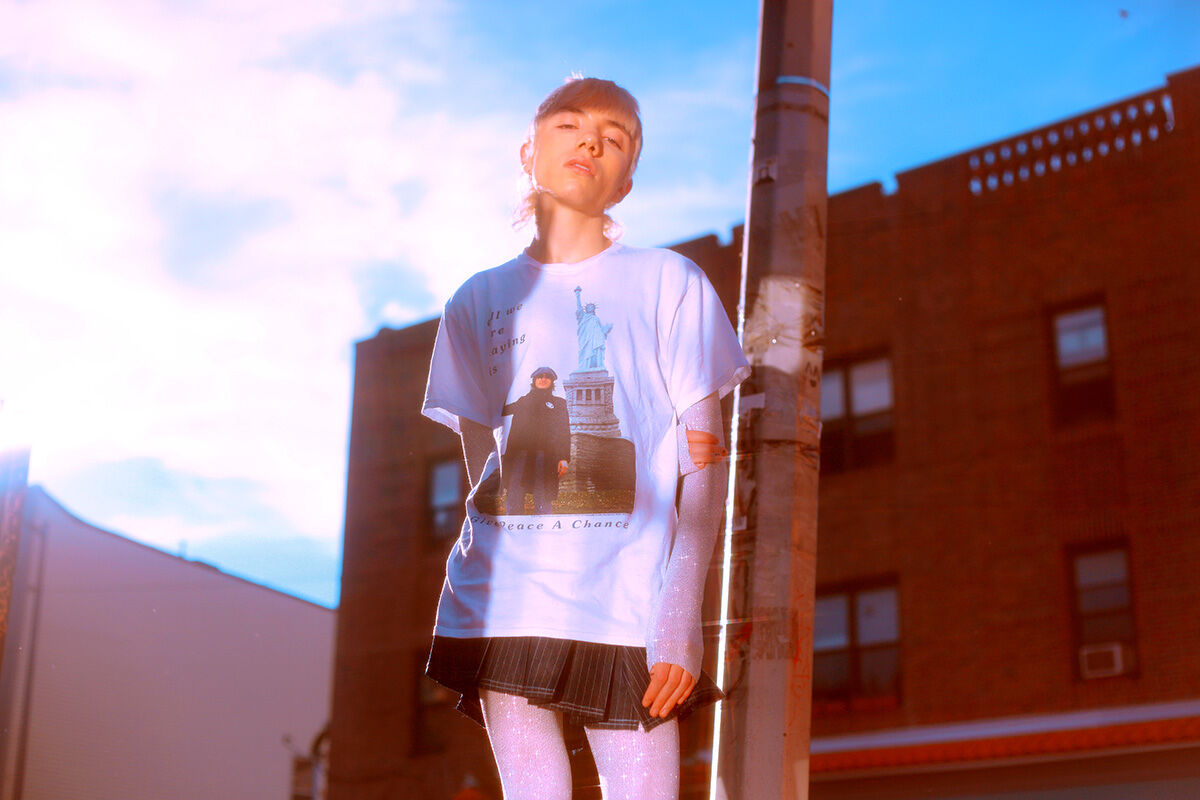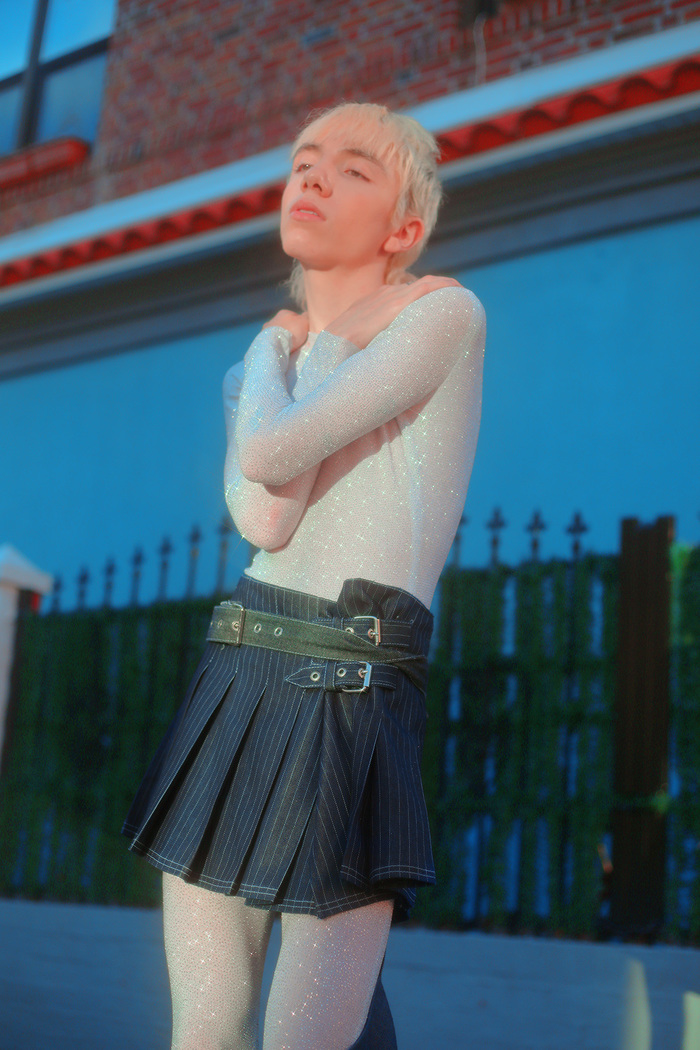As the fashion industry moves away from rich children of celebrities as faces of their brands, the new supermodel has evolved to see the queer kids and the outsiders take the torch. With top brands embracing the queer community en masse, the cookie cutter standards of beauty are being redefined.
But for Jovel Ramos, the industry still has a long way to go before queer people feel the respect they deserve. The young model moved to New York at 17, and he’s gone on to model for Hood by Air and Maison the Faux. His unique look stems from his bold expression of femininity, something that took time for him to fully embrace in the face of the industries standards of masculinity.
As Ramos’ brand as a queer model rises in the era of Instagram and self-made celebrity, he’s using his platform for good. Last year, he released a capsule collection that benefitted the queer youth of New York’s Ali Forney Center. As he aims to collaborate with more organizations of similar missions, he continues to tear down the boundaries of the fashion industry and rebuild it for the queer kids like himself.
We recently spoke with Ramos about his introduction to the New York fashion scene and his struggle for social acceptance.
Subscribe to get a twice-weekly dose of queer news, updates, and insights from the INTO team.
in Your Inbox
Growing up in Massachusetts, did your family and your peers make you feel comfortable with experimenting with femininity and your own fashion sense?
It may be because I came from a small town but growing up, I definitely knew I deviated from society. Everything was sort of predetermined for you based on gender.
Fashion was always an escape for me, even though overcoming the stigma of men’s versus women’s clothing was always a struggle that really confused me in developmental years. I’ve always gravitated towards women’s clothing and things that are deemed “feminine” so the majority of my experimenting growing up was done in secrecy. Whenever I did experiment with my look I was bombarded with disapproval which really prevented me from coming into who I am as a person. I was able to push through it and knew things would be different in the long run, but what about kids that don’t know that? I think I really found myself and came into my own when I was 17 and moved to New York.
Who were some of your fashion icons when you were growing up?
I’ve always loved 90’s Thierry Mugler, Galliano era Dior, and Tom Ford era Gucci. But beyond that, I was always obsessed with supermodels – Naomi, Linda, Kate Moss, Edie Sedgwick.
What was your first impression of coming to New York and experiencing the fashion industry first-hand?
I was excited, scared, and extremely naive to everything. When I got to New York, it was such a relief, and I fell in love with the city. It was like most scenarios you hear about, a small-town boy shows up to the big city, doe-eyed, full of hope. I was scouted shortly after moving here, and that’s when I saw the industry first hand. When I first started modeling, I was so intimidated by everything. I was 17 years old when I walked Hood by Air. I remember being backstage in nothing but a nude thong and being mesmerized by the chaos. Ever since then, I fell in love with the madness and the glamour. That was probably one of my first real impressions.
Did you find the fashion industry to be pretty welcoming at first or did you have to conform to certain standards set by other models?
When I first started, I felt so much pressure to conform to certain masculine standards of beauty. A lot of people think that everything is black and white when it comes to gender, but there’s an entire grey area that nobody really addresses. Society doesn’t tell you that you can fall into that grey area, and I want that to be more welcoming for kids growing up trying to identify themselves. There’s little to no representation for people who don’t abide by gender norms. My feminine presence doesn’t mean I want to completely dispose of my masculine side. The industry puts a lot of pressure on you, but I’ve learned to do whatever makes me happy.
How do you think the fashion industry needs to evolve to further welcome queer models and designers?
I think that the fashion industry has come a long way, but I still think we have so much more to go. Things need to be more organic. In a lot of cases, we’re used as a cheap marketing ploy, or we’re looked at like we’re some type of fad. We’re here, and we’re here to stay, so respect us, pay us, and use the correct pronouns.
Instagram is such a huge part of developing your brand in the fashion industry these days. Did that come natural to you, having grown up in the digital era?
Yeah, I think it did come natural. Social media has played a huge role in my career because it’s a space where I can organically be myself, and I’m extremely grateful for that.
Being so bold and expressive of your own unique fashion sense, do you find more positive or negative feedback on social media? Or do you even pay attention to the comments?
I try not to pay attention to the comments, good or bad. Normally it’s my friends that show me the hate. I think it’s so funny sometimes, I’ve learned to laugh at it.
It looks like you have a group of friends that share your bold approach to style and gender expression. Do you find that support system to still be important personally or has most of the industry embraced you?
Absolutely, yes. As queer people, we get to choose our families. I wouldn’t be anywhere if it wasn’t for my friends. It’s so beyond important to have a tight knit second family. I don’t think the industry has fully embraced me entirely at all. I still think there’s so much work to be done, but I’m hopeful.
You recently released a collection that benefits Ali Forney Center. Why was that cause important to you?
My capsule collection collaborating with The Ali Forney Center was so important to me for a number of reasons. 40% of homeless youth in New York City is compiled of LGBTQ+ adolescence. Our community is so ostracized, and it’s so important for us to stick together and give back to our community. I grew up with little to nothing so I know what it’s like to feel like nobody wants to see you succeed. There are so many odds against you when you’re a minority in any form.
Any other plans of collaborating with queer organizations in the future?
I’d love to continue what I do and collaborate with more queer organizations. I’d love to work with GLAAD or the It Gets Better project. We have come a long way but it’s important for us to fight and stay visible. My goal is to eventually do a TED Talk to explain how damaging it is growing up in a world that’s pink or blue. I think the stigma around GNC kids is so unfeasible due to the ignorance of it and I want to help people understand it.
Do you find modeling and being visible as a queer person to be a form of protest?
In a sense, yes. I do consider it a form of protest. But in reality, I’m just being myself.
Follow Jovel Ramos on Instagram.
___
Styling credit:Jared Martell
Photographer:Israel Riqueros
Stylist

















